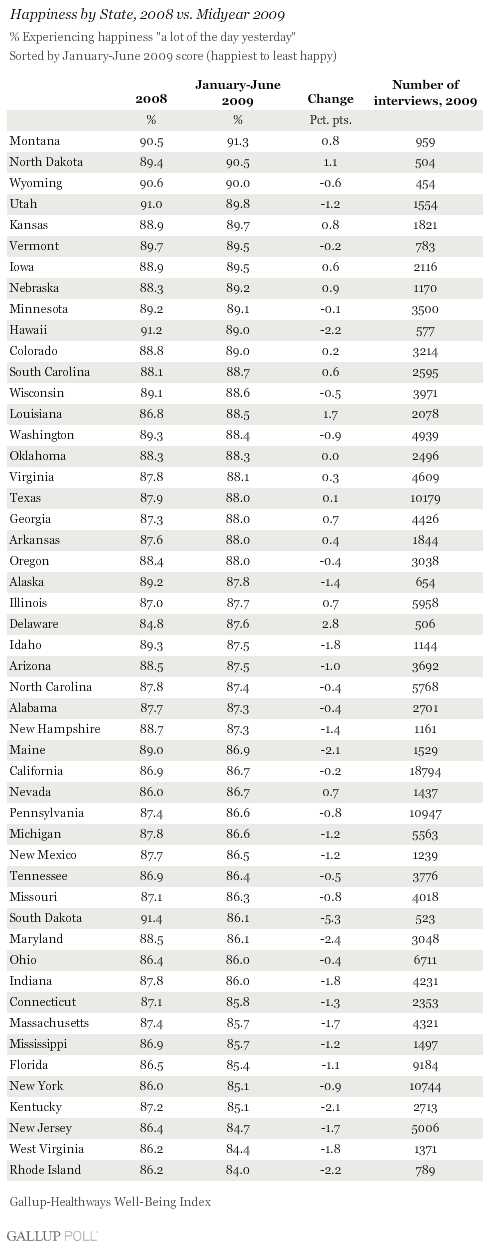WASHINGTON, D.C. -- Residents of Hawaii and North Dakota had the lowest stress levels in the nation in the first half of 2009. Kentucky and West Virginia, two states that border each other, share the unhappy distinction of having residents with the highest stress levels.

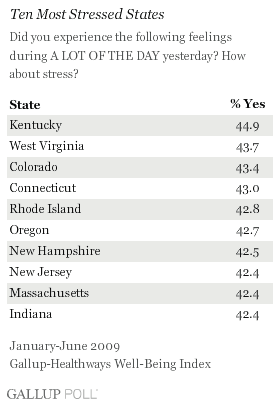
These state-level data are from the Gallup-Healthways Well-Being Index. The stress score for each state is simply the percentage of residents during the first six months of 2009 who report that they experienced stress "during a lot of the day yesterday." The January-June 2009 aggregate includes more than 170,000 interviews conducted among national adults, aged 18 and older.
It is easy to imagine why many Hawaii residents might not feel stressed (think perpetual summer and beaches). The low percentage of stress among North Dakotans is likely explained by additional Gallup-Healthways data showing that North Dakota leads the nation in the Gallup-Healthways Physical Health Index. North Dakota's very low population density may also contribute to a less stressful lifestyle. Supporting the latter hypothesis is the fact that the 5 least densely populated states in the U.S. (Alaska, Wyoming, Montana, North Dakota, and South Dakota, in that order) all made the list of the 10 least stressed states. Densely populated Maryland is a noteworthy exception to this trend.
The states in which the highest percentage of people report being stressed have a mixture of population densities, with 5 of the 10 most stressed states being concentrated on the Eastern seaboard (Connecticut, Rhode Island, New Hampshire, New Jersey, and Massachusetts). (See page 2 for a complete list of state Stress scores.)
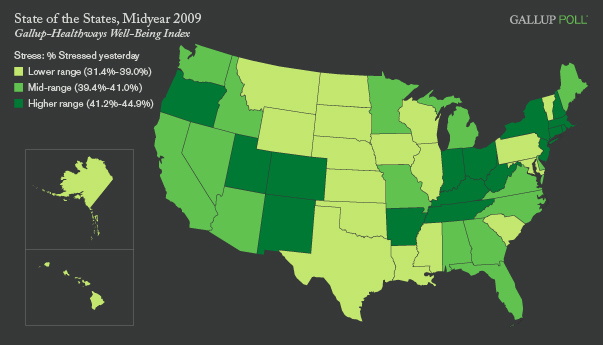
Happiness Not Quite the Opposite of Stress
The happiness score for each state is the percentage of residents during the first six months of 2009 who report that they experienced happiness "during a lot of the day yesterday." Because people rarely feel happy when they feel stressed, it seems reasonable to assume that the states with the lowest stress levels might also be the states in which the greatest percentage of people report being happy. This is generally the case. In fact, 6 of the 10 states with the lowest stress levels also made the list of the 10 happiest states. These states are Hawaii, North Dakota, Iowa, Wyoming, Kansas, and Montana. Seven of the 10 most stressed states also ranked in the bottom 10 in happiness. These are Kentucky, West Virginia, Connecticut, Rhode Island, New Jersey, Massachusetts, and Indiana. In general, there is not a lot of variation in reported happiness among the states, with just seven percentage points separating the top and bottom states.

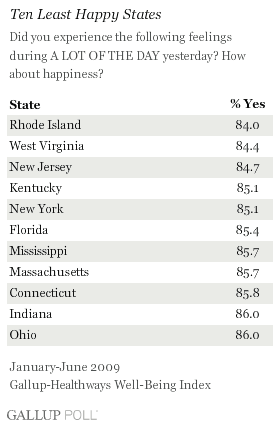
There are some interesting exceptions to the rule that states in which more people are stressed usually have fewer people who are happy. The most striking of these is Colorado, which tied for 10th highest in happiness while ranking as the third highest in stress. Relative to the residents of other U.S. states, that is, residents of Colorado somehow managed to be relatively happy while also being very stressed. (See page 3 for a complete list of state Happiness scores.)
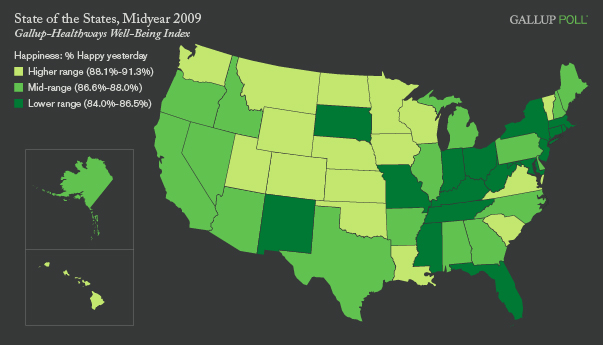
Change Over Time
In comparison with the total 2008 figures, the percentage of Americans so far this year who report having been happy has changed little, going down less than one point (from 87.9% to 87.2%). Likewise, the percentage who report having been stressed has increased only about one point in the same period (from 38.8% to 40.0%). Other Gallup-Healthways research documents that social time spent with friends and family is one of the strongest determinants of happiness, more so than outside factors such as financial worry. So in spite of the economic downturn, Americans' patterns and amount of time spent with friends and family may not have changed much from 2008 to 2009. Alternatively, happiness and stress may simply be highly stable measures that, in the absence of truly radical forces, do not show much change over time.
Bottom Line
Despite the tough economic times, the vast majority of Americans in all states report experiencing a lot of happiness, and that has been consistent from 2008 to 2009. Likewise, although a substantial percentage of Americans report feeling stressed, reports of stress remain below the majority level in all states and have not increased much despite the challenging economic times.
Gallup.com's "State of the States" series reveals state-by-state differences on political, economic, and wellbeing measures Gallup tracks each day, based on data collected between January and June 2009. To see all stories published in the midyear 2009 series, click here. New stories will be released throughout the month of August.
Survey Methods
Results are based on telephone interviews with 178,545 national adults, aged 18 and older, conducted Jan. 2-June 30, 2009, as part of the Gallup-Healthways Well-Being Index. For results based on the total sample of national adults, one can say with 95% confidence that the maximum margin of sampling error is ±0.2 percentage points.
The margin of sampling error for most states is ±1-2 percentage points, but is as high as ±4 percentage points for smaller states such as Wyoming, North Dakota, South Dakota, Delaware and Hawaii.
Interviews are conducted with respondents on land-line telephones (for respondents with a land-line telephone) and cellular phones (for respondents who are cell-phone only).
In addition to sampling error, question wording and practical difficulties in conducting surveys can introduce error or bias into the findings of public opinion polls.
About the Gallup-Healthways Well-Being Index™
The Gallup-Healthways Well-Being Index is the first and largest survey of its kind, with 1,000 calls a day, seven days a week. It is the official statistic for Wellbeing in America, giving a daily measure of people's wellbeing at the close of every day based on the World Health Organization (WHO) definition of health as not only the absence of infirmity and disease but also a state of physical, mental and social wellbeing. The Well-Being Index will be a daily measure determining the correlation between the places people work and the communities in which they live, and how that and other factors impact their wellbeing. Additionally, the Well-Being Index will increase the understanding of how those factors impact the financial health of corporations and communities. For additional information, go to www.well-beingindex.com.

